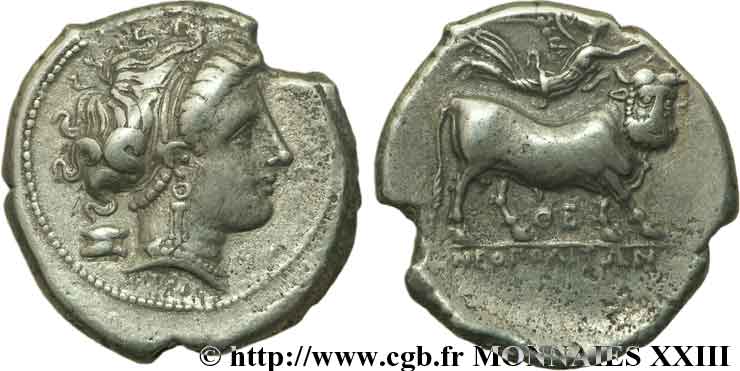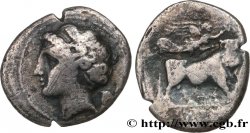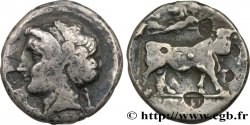v23_0002 - CAMPANIA - NEAPOLIS Nomos ou didrachme
MONNAIES 23 (2004)
Precio de inicio : 200.00 €
Valoración : 350.00 €
Precio realizado : 200.00 €
Número de ofertas : 1
Oferta más alta : 200.00 €
Precio de inicio : 200.00 €
Valoración : 350.00 €
Precio realizado : 200.00 €
Número de ofertas : 1
Oferta más alta : 200.00 €
Tipo : Nomos ou didrachme
Fecha: c. 326/317-290 AC.
Nombre del taller / ciudad: Nápoles
Metal: plata
Diámetro: 22 mm
Eje de acuñación: 2 h.
Peso: 7,02 g.
Comentarios sobre el estado de conservación:
Flan très large, mais échancré à 1 heure. Beau portrait de style très fin, bien centré des deux côtés. Métal très légèrement piqué au revers à l’exergue
N° en los catálogos de referencia :
Anverso
Descripción del anverso: Tête de la nymphe Parthénopé ou Néapolis à droite, la chevelure bouclée, ceinte d’un bandeau avec collier et boucle d’oreille ; derrière la tête, un osselet.
Leyenda del anverso: [ARTEMI]
Reverso
Descripción del reverso: Taureau androcéphale passant à droite, la tête barbue de face, couronné par Niké volant à droite ; entre les pattes, deux lettres.
Leyenda del reverso: NEOPOLITW[N]/ QE
Comentario
Poids léger. Pour ce type, A. Sambon signalait déjà en 1903 que le nom au droit sous la tête de la nymphe doit être restitué sous la forme (Artemion ou plutôt Artemidoros). Sur notre exemplaire, le nom sous la tête de la nymphe n’est pas lisible et semble gravé en creux. Le visage présente une attitude altière avec une chevelure très ornementée qui n’est pas sans rappeler les représentations syracusaines. C’est l’un des types les plus courants du monnayage napolitain. Au droit, derrière la tête de la nymphe, nous avons la représentation d’un osselet ou astragale qui servait dans des jeux de hasard et d’adresse. Les osselets étaient en os ou en bronze et sont souvent figurés dans l’art grec (cités par Pline l’Ancien dans son Histoire Naturelle, HN. XXIV, 19,2).
Light weight. For this type, A. Sambon already pointed out in 1903 that the name on the obverse under the nymph's head should be restored in the form (Artemion or rather Artemidoros). On our example, the name under the nymph's head is not legible and seems to be engraved in hollow. The face presents a haughty attitude with highly ornamented hair that is reminiscent of Syracusan representations. This is one of the most common types of Neapolitan coinage. On the obverse, behind the nymph's head, we have the representation of a knucklebone or astragalus that was used in games of chance and skill. Knucklebones were made of bone or bronze and are often depicted in Greek art (cited by Pliny the Elder in his Natural History, HN. XXIV, 19,2)
Light weight. For this type, A. Sambon already pointed out in 1903 that the name on the obverse under the nymph's head should be restored in the form (Artemion or rather Artemidoros). On our example, the name under the nymph's head is not legible and seems to be engraved in hollow. The face presents a haughty attitude with highly ornamented hair that is reminiscent of Syracusan representations. This is one of the most common types of Neapolitan coinage. On the obverse, behind the nymph's head, we have the representation of a knucklebone or astragalus that was used in games of chance and skill. Knucklebones were made of bone or bronze and are often depicted in Greek art (cited by Pliny the Elder in his Natural History, HN. XXIV, 19,2)








 Informar de un error
Informar de un error Imprimir la página
Imprimir la página Comparte mi selección
Comparte mi selección Haz una pregunta
Haz una pregunta Consignar / vender
Consignar / vender
 Descriptivo
Descriptivo









